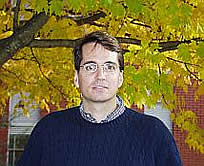|
Home
Research Interests
Graduate Research
Undergraduate Research
Publications
Quantum Movies Class Info
|
Collective photon-atom interactions
Atoms can strongly interact with photons when light is resonant (or
nearly so) with dipole allowed transition. Because the field from the
photon transition decays like 1/distance from the source, atoms separated by distances
comparable to the photon wavelength can strongly interact. The
formalism for the interaction of atoms through the photon field has
been well known for many decades. In recent years, there is renewed
interest because of experimental cases where the interaction is strong
enough to lead to collective behavior. These systems are distinct from those for Rydberg-Rydberg interaction because
the atoms interact through the retarded electromagnetic field while the
Rydberg gases interact through the near-field (electrostatic)
interaction.
We study this system for its fundamental novel collective behavior and
for its impact on properties of quantum computers and simulators. We
have studied several aspects of how the collective interaction can
change the lifetime of excited states through superradiance and
subradiance effects. We have studied how the photon interaction with a
group of atoms leads to a specific atom to recoil and how this can lead to
decoherence in quantum simulators. We have also studied how an inverted
(or nearly inverted) gas decays by photon emission depending on the
properties of the states that the excited state can decay into.
Below is a brief
description of results in two recent publications.
Deepak A. Suresh and F.
Robicheaux, “Photon-induced atom recoil in collectively interacting
planar arrays,” Phys. Rev. A 103,
043722 (2021). PDF
(655 kB) (data for figures at https://doi.org/10.4231/HHNZ-SP39)
In this paper, we studied how atoms in an array recoil due to the
emission or absorption of a photon. This is an important question
because an atom that recoils can have its center-of-mass motion
entangle with internal degrees of freedom which leads to unwanted
decoherence in the operation of quantum simulators or computers. This
is not a simple question because a photon can distribute the recoil
over many atoms. We also found cases where a single photon could lead
to 1000X the expected recoil energy deposited into a single atom. Also,
the interference between the incident and scattered photon field can
lead to nontrivial patterns of energy deposition in the array.
The left image shows the electric field for a proposed cavity composed
of atoms on a grid; the bright spots are the positions of the atoms
which enhance the intensity in their neighborhood. The proposal did not
account for the possible recoil of the atoms in the array. The right
image shows the recoil energy for an example cavity. Note that
the center atom gains approximately 1000 recoil energies before
the photon is lost from the cavity. This high recoil results from the
photon bouncing many times between the mirrors constructed from the
atom arrays.
These images are for light perpendicularly incident on an 11X11 array
of atoms. The left plot shows the probability for each atom in the
array to be excited by the photon. The right plot shows the amount of
recoil energy deposited into each atom per photon incident on that
atom. Although each photon can only interact once with the array, many
of the atoms gain more than 2 recoil energies. Also, there is a highly
nontrivial pattern of energy deposition which roughly matches the
pattern of excitation of the array.
F. Robicheaux and R.T.
Sutherland, “Photon scattering from a cold, Gaussian atom cloud,” Phys.
Rev. A 101,
013805 (2020). PDF
(1130 kB)
In this paper, we study a weak laser interacting with a cloud of
atoms and how the atoms can scatter, focus, or defocus the light beam.
Since atoms are typically very diffuse, researchers often neglected the
ability of the atoms to change the light beam. We devised a
computational method to treat cases with over 100,000 atoms which is
10X more than any previous calculation.
This image shows a 2D slice of the magnitude of the electric
field of the light times the Gaussian density of atoms. The atom cloud
is centered at the origin and the light is travelling toward +z. The
optical depth of the cloud, through its center, is 64 meaning that the
light should only be able to penetrate a short distance through the
cloud. This is seen in the left image where the light is on resonance
with the transition. The largest value of |E| times density is where
the density is quite small but very little of the light has been
scattered out of the beam. The right image is when the light is red
detuned and shows a counterintuitive effect. There is more light behind
the peak density of the atom cloud. This is because for red detuning
the cloud focuses the light into the atom cloud. This scattering or
focussing effect can strongly affect the interpretation of experiments
and undermine quantum simulators.
Five Recent
Publications
F.
Robicheaux and Deepak A. Suresh, “Beyond lowest order mean-field theory
for light interacting with atom arrays,” Phys. Rev. A 104,
023702 (2021). PDF
(519 kB) (data for figures at https://doi.org/10.4231/YWCS-A844)
E. Kur, F. Robicheaux, N. Evetts, J.
Fajans, A. Guerra IV, W.N. Hardy, E.D. Hunter, Z.T. Schroeder, and J.S.
Wurtele, "Computational and theoretical analysis of electron plasma
cooling by resonant interaction with a microwave cavity," Phys. Plasmas
27, 082101 (2020). PDF
(1290 kB)
F.
Robicheaux and Shihua Huang, "Atom recoil during coherent light
scattering from many atoms," Phys. Rev. A 99, 013410 (2019). PDF
(603 kB)
R.T. Sutherland and F.
Robicheaux, "Superradiance in inverted multilevel atomic clouds," Phys.
Rev. A 95,
033839 (2017). PDF
(850 kB) Erratum
R.T. Sutherland and F.
Robicheaux, "Collective dipole-dipole interactions in an atomic array,"
Phys. Rev. A 94,
013847
(2016). PDF
(815 kB)
|

robichf[at]purdue.edu
284 Physics Building (Office)
+1 765 494 3029 (Office)
+1 765 494 0706 (FAX)
Mail:
Department of Physics
525 Northwestern Avenue
West Lafayette, IN 47907
Links:
Phyics
Department
Purdue University
ALPHA Project
|

